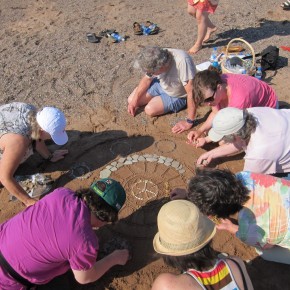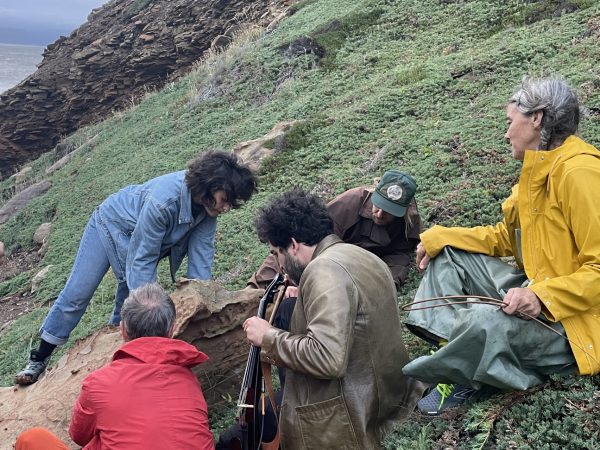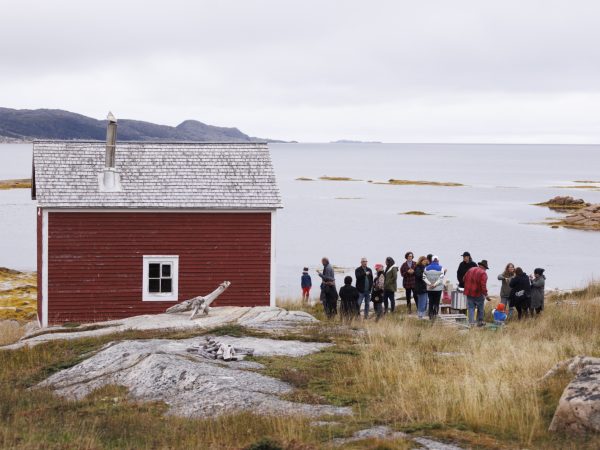
Installation view of Rita McKeough’s performance project Alternator, MASS MoCA, North Adams, Mass., May 25-27, 2012.
Photo: Kay Burns
Of the 62 Canadian artists featured in MASS MoCA’s extensive Oh Canada exhibition in North Adams, Massachusetts, several allude to the effect of dislocation and relocation in their artwork. The exhibition is the culmination of five years of research and planning by MASS MoCA curator Denise Markonish, who spent three years travelling to almost every Canadian province and territory to undertake 400 studio visits, selecting over 100 works for exhibition. With this Canadian show, in a place that is elsewhere, we find an exhibition rife with implications of displacement, rooted perhaps in some kind of quest for belonging.
This exhibition prompted me to question what defines an Atlantic Canada artist. Is it someone who is born here, lives here now, has spent a significant amount of time here or has been educated here? This exhibition has instigated a number of articles from various regions laying claim (past or present) to a certain percentage of artists from the show.1 What this perhaps indicates, is that Canadian artists are a nomadic bunch of people who move for teaching gigs, for education, for residencies and exhibitions, all of which have an impact on the evolution of their work and on the location that they call home. The artists of Canada belong to a relatively small community, frequently and happily following erratic migratory patterns.

Artist Graeme Patterson and his multimedia installation The Mountain, 2012. 20ft x 10ft x 8ft. Photo: Kay burns
Andrea Mortson, who has lived in Sackville for 15 years, reflects on her paintings: “The landscapes are based on real places that I feel a strong connection to. I used to move around a lot, and my paintings were always influenced by places I’d been … My practice is very much inspired by where I am right now.”2 While Mortson’s work frequently includes imagery of the landscape that surrounds her, there is also the sense in the work that it is an imagined place, something derived from memory and things less tangible than specific sites—an amalgamation of lived place and quixotic place. Her works in this exhibition also incorporate the presence of the figure, something she steered away from for an extended period of time. The painting New Hope for Memories that Can’t Waitfor example, includes images of people, based on friends of hers in Sackville. It is this presence of the figures that helps situate remembered place as an element of physical place.
Halifax-based artist, Kim Morgan’s Range Light, Borden-Carleton, PEI brings a bit of PEI’s Borden-Carleton community to North Adams. The work is a full-scale interior and exterior latex cast of the decommissioned lighthouse that it’s named for. Morgan began casting architectural forms in 2001 during her graduate studies in Saskatchewan. “Growing up on the Saskatchewan Prairies, I was surrounded by endless space. My landmarks were wooden grain elevators, and they too have been torn down,” recalls Morgan. “For me it was an easy shift from abandoned grain elevators to the decommissioning of the lighthouses in my new home in the Maritimes.”3
Graeme Patterson’s animation/sculptural project The Mountain, stems from a number of influences including a fascination with the idea of a man-made mountain. Patterson currently resides in Sackville, but is originally from Saskatchewan and has lived in the Maritimes for a combined total of about ten years. In part, landmarks he knows from Saskatchewan have informed his project, such as a man-made ski hill known as Mount Blackstrap. Patterson’s installation is part of a larger body of work that deals with ideas pertaining to male friendship. The Mountain is a kind of self-portrait, inspired by his memories of his very first friend; the house structures in the installation represent his childhood home and the home of his friend, which are joined by tunnels to the Mountain. Within the mountain is a kind of oversized playroom (in miniature)—a ‘dream studio’ that incorporates video animations and multiple structures, alluding to a notion of play that is associated with both childhood fun and creative practice.
Nova Scotia-born artist Rita McKeough’s outdoor performance project at MASS MoCA, Alternator, shows influences from her 2007 move to Calgary to undertake a teaching position at Alberta College of Art and Design. The ubiquitous presence of oil pumps all over Alberta, the prevalent issues regarding the finite quantity of oil and the environmental implications of its extraction were all part of the place McKeough encountered. Her tongue-in-cheek performance work consists of an assembly of miniature oil pumps placed on small oil leaks and stains in parking lots in an attempt to extract the residue, with pipes running from the pumps to a 45 gallon drum as the collection vessel. These pumps are set in motion by electricity generated from a steering wheel that McKeough (or audience participant) must continually turn to work the pumps; the irony being that unless you are driving you cannot pump the oil needed to power the car.

Installation view of Kim Morgan’s Range Light, Borden-Carleton, PEI (2010), latex with wood framing and rope rigging,
18 metres long, MASS MoCA, North Adams, Mass.,
May 25, 2012-April 1, 2013.
Photo: Kay burns
Eryn Foster’s MASS MoCA performative installation project, A Gift of Cultured Culture involved her collecting wild yeasts from around the town of North Adams to develop sourdough starter. Foster (and assistants) built an outdoor brick oven to cook the bread in, serving tasty samples to countless guests during the opening festivities. Born and raised in Ontario, Foster spent ten years in Halifax, and plans to return to Atlantic Canada in August 2012, after having spent the past two years in Dawson City, Yukon. While using sourdough is a relatively common approach to bread making, there is an exceptionally strong connection between sourdough and the patterns of settlers and explorers who ventured north. In the early gold rush days, most miners carried a pouch of sourdough in their supplies because of its ability to withstand cold temperatures. The term sourdough has even worked its way into local vernacular, describing a person who is a permanent resident of the Yukon or who has lived there during all four seasons. The local affinity for sourdough inspired Yukon poet Robert Service to create a book of poems, Songs of a Sourdough, and there is a long-running annual winter festival in Whitehorse, the Sourdough Rendezvous.
Would many of the artworks in this exhibition have been made if it were not for the migration patterns of artists, gathering influences (like the collection of wild yeasts) from the ambience of the places in which they have lived? The MASS MoCA exhibition was not organized in a geographical manner within the gallery. But the catalog has been sectioned geographically, even though the correlation between artist and place of belonging is often quite ambiguous. The migration patterns and transience of artists, however, leads to a diverse interpretation of the experience of place in the elastic and undulating topography of Canadian art.
Notes:
1) For example: Sky Goodden, Concordia Progeny Produce One Quarter of MASS MoCA’s “Oh Canada,” http://ca.artinfo.com/news/story/804822/concordia-progeny-produce-one-quarter-of-mass-mocas-oh-canada; Mike Landry, “Sackville a meeting place for contemporary artists,” Telegraph-Journal, May 25, 2012; “Oh Canada, Oh NSCAD,” NSCAD University, April 3, 2012, http://nscad.ca/en/home/abouttheuniversity/ news/MASS MoCA-040312.aspx
2) MASS MoCA, Oh, Canada catalog, (scheduled for release mid July 2012), 295.
3) ibid, p 318
















Leave a Reply